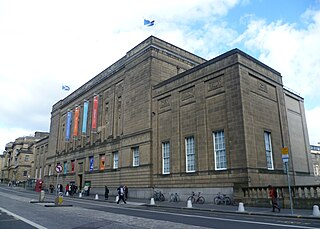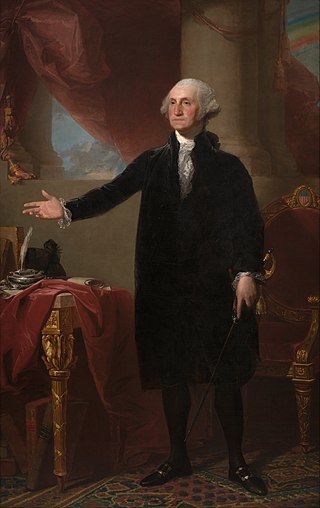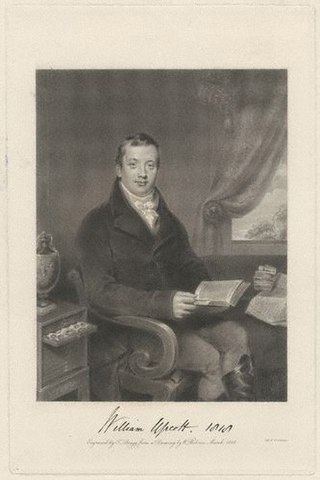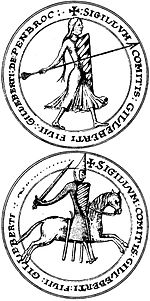Sir Frederic Madden KH was an English palaeographer.
Sir (Nicholas) Harris NicolasGCMG KH was an English antiquary.

Sir James Edward Smith was an English botanist and founder of the Linnean Society.

The National Library of Wales, in Aberystwyth, is the national legal deposit library of Wales and is one of the Welsh Government sponsored bodies. It is the biggest library in Wales, holding over 6.5 million books and periodicals, and the largest collections of archives, portraits, maps, and photographic images in Wales. The Library is also home to the national collection of Welsh manuscripts, the National Screen and Sound Archive of Wales, and the most comprehensive collection of paintings and topographical prints in Wales. As the primary research library and archive in Wales and one of the largest research libraries in the United Kingdom, the National Library is a member of Research Libraries UK (RLUK) and the Consortium of European Research Libraries (CERL).

The National Library of Scotland is one of the country's National Collections. It is one of the largest libraries in the United Kingdom. As well as a public programme of exhibitions, events, workshops, and tours, the National Library of Scotland has reading rooms where visitors can access the collections. It is the legal deposit library of Scotland and is a member of Research Libraries UK (RLUK) and the Consortium of European Research Libraries (CERL).

The Cotton or Cottonian library is a collection of manuscripts that came into the hands of the antiquarian and bibliophile Sir Robert Bruce Cotton MP (1571–1631). The collection of books and materials Sir Robert held was one of the three "foundation collections" of the British Museum in 1753. It is now one of the major collections of the Department of Manuscripts of the British Library. Cotton was of a Shropshire family who originated near Wem and were based in Alkington and employed by the Geneva Bible publisher, statesman and polymath Sir Rowland Hill in the mid 16th century.

The Lansdowne portrait is an iconic life-size portrait of George Washington painted by Gilbert Stuart in 1796. It depicts the 64-year-old president of the United States during his final year in office. The portrait was a gift to former British Prime Minister William Petty, 1st Marquess of Lansdowne, and spent more than 170 years in England.

The Wellcome Library is a free library and Museum based in central London. It was developed from the collection formed by Sir Henry Wellcome (1853–1936), whose personal wealth allowed him to create one of the most ambitious collections of the 20th century. Henry Wellcome's interest was the history of medicine in a broad sense and included subjects such as alchemy or witchcraft, but also anthropology and ethnography. Since Henry Wellcome's death in 1936, the Wellcome Trust has been responsible for maintaining the Library's collection and funding its acquisitions. The library is free and open to the public.

The Rosenbach is a Philadelphia museum and library located within two 19th-century townhouses. Established as a testamentary gift in 1954. The historic houses contain the donated collections of Philip Rosenbach and his younger brother Dr. Abraham Simon Wolf Rosenbach.

White Kennett was an English bishop and antiquarian. He was educated at Westminster School and at St Edmund Hall, Oxford, where, while an undergraduate, he published several translations of Latin works, including Erasmus' In Praise of Folly.

Sir Thomas Phillipps, 1st Baronet, was an English antiquary and book collector who amassed the largest collection of manuscript material in the 19th century. He was an illegitimate son of a textile manufacturer and inherited a substantial estate, which he spent almost entirely on vellum manuscripts and, when out of funds, borrowed heavily to buy manuscripts, thereby putting his family deep into debt. Phillipps recorded in an early catalogue that his collection was instigated by reading various accounts of the destruction of valuable manuscripts. Such was his devotion that he acquired some 40,000 printed books and 60,000 manuscripts, arguably the largest collection a single individual has created, and coined the term "vello-maniac" to describe his obsession, which is more commonly termed bibliomania.

Dr Eileen Joyce Harris is an American/English architectural historian and author. She is an expert on Robert Adam and is Honorary Librarian and Consultant to the Adam Project at Sir John Soane's Museum in London.

The British Library is a research library in London that is the national library of the United Kingdom. It is one of the largest libraries in the world. It is estimated to contain between 170 and 200 million items from many countries. As a legal deposit library, the British Library receives copies of all books produced in the United Kingdom and Ireland, including a significant proportion of overseas titles distributed in the UK. The Library is a non-departmental public body sponsored by the Department for Culture, Media and Sport.
William Reeves was an Irish antiquarian and the Church of Ireland Bishop of Down, Connor and Dromore from 1886 until his death. He was the last private keeper of the Book of Armagh and at the time of his death was President of the Royal Irish Academy.
Nicholas Charles or Carles was an English officer of arms, who served as Lancaster Herald from 1609 to 1613. He made a copy of an early and rare 13th-century roll of arms, the original of which is now lost, known after him as "Charles's Roll".

William Upcott (1779–1845) was an English librarian and antiquary.
Kennett Farrar Potter Love was an American journalist for The New York Times.
Basil Kennett was a Church of England cleric who served as the first chaplain to the British Factory at Leghorn. An academic, writer and translator, Kennett was elected president of Corpus Christi College, Oxford, serving for a short time before his early death. His 1696 Romæ Antiquæ Notitia, or the Antiquities of Rome was considered the subject's standard handbook for a century.

Books in the United Kingdom have been studied from a variety of cultural, economic, political, and social angles since the formation of the Bibliographical Society in 1892 and since the History of books became an acknowledged academic discipline in the 1980s. Books are understood as "written or printed work consisting of pages glued or sewn together along one side and bound in covers".

The Hon. Dudleya North was an English aristocrat, orientalist, linguist and classical scholar.














